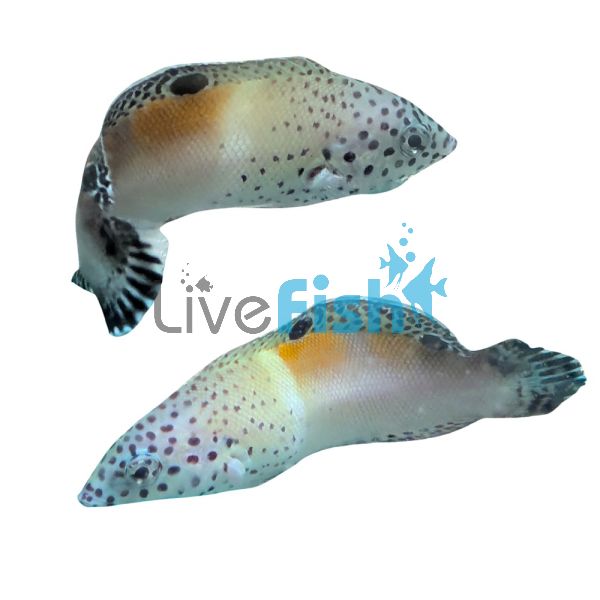Twin Spot Wrasse - Medium
The Twin Spot Wrasse is an interesting species. It undergoes an incredible transformation as it matures. Suitable for more experienced aquarists who understand how its needs will change.
The colouration and patterning of the Twin Spot Wrasse changes significantly over time. Juveniles have a white body with black dots on the front half of the body. The rear half has two big orange spots on the upper back and its fins are dark with thin white edging. Young adults change colour when they reach around a foot (30 cm) in length. Adult males and females differ in appearance. Males that breed are dark green, with a hump on their head and a vertical bar behind the pectoral fin. Nonbreeding males have a much duller appearance. Females have a light grey head with dark red spotting on the front of their body as well as spots on their fins. A white bar separates the front of the body from the darker rear. This species grows to a considerable size, reaching a length of 24 inches (61 centimetres).
There are no reports of Twin Spot Wrasse breeding in captivity. In the wild they are pelagic spawners whose eggs drift with the currents. A male will have a harem of females to breed with. If a male isn’t present, one of the larger females may transform into a male. This creates a constant supply of breeding partners.
The Two Spot Wrasse can be found in Indo Pacific areas. Its distribution spreads from Africa & the Red Sea to southern Japan and Lord Howe Island. It is a coral reef dweller preferring rubble or of sandy areas. Usually between depths of 2 to 30 meters (6.6 to 98.4 ft). Adults are often solitary, whereas youngsters often inhabit tide pools.
Tank Recommendations for your Twin Spot Wrasse
Adults will need a tank that holds at least 300 gallons (1,126 litres).
They aren’t suitable for reef tanks and should kept in a fish-only aquarium. Rocky caves and open areas for swimming are preferrable.
Twin Spot Wrasses are known to move rocks and corals, usually while hunting for small invertebrates and fish.
Suitable Tank Buddies
This species is known to be aggressive with other species.
It is most suited to a community tank with larger aggressive and semi aggressive fish.
Usually Compatible
Preferable tank buddies include Angelfish, Groupers, Hawkfish, and Triggerfish. Conspecifics are ok if a male and a group of females are introduced simultaneously.
Sometime Compatible
Caution is advised with Dartfish, Squirrelfish, Batfish, Hogfish, Pufferfish, and Eels.
Rarely Compatible
Avoid slow movers such as Seahorses or Pipefish, which are too delicate to cohabit. Smaller fish and crustaceans are likely to be consumed when the Twin Spot Wrasse hunts for food.
Feeding your Twin Spot Wrasse
This species is carnivorous. They need a meaty diet, containing foods like fortified Mysis and Brine shrimp. It can also consume high quality flakes and pellets. We recommend that you feed them twice a day.
| Scientific Name | Coris aygula |
|---|---|
| Care Level | Hard |
| Common Names | Twin Spot Wrasse, Two Spot Wrasse, Clown Coris, Twinspot Coris, Coris Wrasse, False clownwrasse, Redblotched wrasse |
| Diet | Carnivore |
| Fish Family | Labridae |
| Lifespan (years) | 10 |
| Max. Length (cm) | 61 |
| Min. Tank Volume (l) | 1126 |
| Origin | Indo-Pacific; Africa, the Red Sea, southern Japan, Lord Howe Island |
| Reef Safe | No |
| Sociability | Aggressive |
| Venomous | No |
| Water Conditions | 1.020-1.025, 72-78° F, dKH 8-12, pH 8.1-8.4 |




